|
|
|
Sort Order |
|
|
|
Items / Page
|
|
|
|
|
|
|
| Srl | Item |
| 1 |
ID:
134183
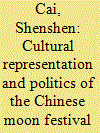

|
|
|
|
|
| Publication |
2014.
|
| Summary/Abstract |
Nationalism in various forms has been a fixture of modern Chinese politics and society; however, its form has changed and over the past decade or so, the CCP has begun to appropriate China's cultural nationalism through its extensive use of propaganda and by other less nefarious methods. This paradigm shift embodies the deliberate manoeuvring that state nationalism is exerting on cultural symbols, concepts and legacies in China. Through imagery and emotionally laden political marketing that favour Party policy and rule, this form of nationalism surreptitiously caters to the cultural tastes of, and appeals to, the emerging middle class of contemporary Chinese society. It is a more nuanced and creative type of propaganda. Using the 2009 China Central Television (CCTV) Moon Festival (Mid-Autumn Festival) Gala as a case study, this paper examines Party-state appropriations of cultural nationalism. The Gala is a rich reservoir of moon-inspired traditional Chinese cultural elements, and the intriguing manoeuvring of these culturally bound images and iconography signifies a new propaganda strategy that combines poetic nostalgia, poignant romance and abstract philosophical pursuit, through which cultural elements are skilfully woven into a patriotic and nationalist appeal. These traditional cultural signifiers, illusions and fantasies serve the Party's political aims as it attempt to reinforce its legitimacy by forging a culturally bound national identity.
|
|
|
|
|
|
|
|
|
|
|
|
|
|
|
|
| 2 |
ID:
100296
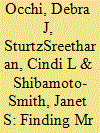

|
|
|
|
|
| Publication |
2010.
|
| Summary/Abstract |
Language standardization lies at the heart of Japanese modernity. And numerous aspects of language development intended to fit the modern Japanese state intersect to regiment the linguistic imaginary regarding women's speech. Focus on Yamanote Tokyo-based joseigo ('women's language'), Standard Japanese and certain urban Kansai dialects in popular text and televisual representations of romantic heroines in geographically and linguistically peripheral areas of Japan has been documented, but has left the issue of linguistic masculinity and the romantic hero unexplored. The relation of male speakers to hyo-jungo was assumed and 'masculine' speaking practices as broadcast in public space have received little attention despite a popular understanding that certain forms (e.g., ore 'I', and assertive sentence final particle zo) are 'masculine' in effect. Here, we examine images of manly men in contemporary romantic representations set in dialect-speaking areas to illustrate the linkages between the romantic hero and the use of Standard Japanese masculine forms and to offer insight into the underexplored set of possibilities for male speakers circulated in popular media.
|
|
|
|
|
|
|
|
|
|
|
|
|
|
|
|
| 3 |
ID:
093490


|
|
|
|
|
| Publication |
2010.
|
| Summary/Abstract |
Rustam is famed for being one of the most fleshed-out characters of the Shahnama. As such, this article will analyze an episode in his life of extreme emotional turbulence, in order to gain a closer understanding of how much realism Firdausi bestows upon his characters. This episode is the suicide attempt he makes following his act of filicide. I will begin with a discussion of the difficulties involved in interpreting such an ancient text as the Shahnama. An analysis of Rustam's background follows, tracing the development of his personality. I will then take a detailed look at the circumstances surrounding his attempted suicide. After this, I will gauge the extent to which this act may have its roots in his personality. By thus examining how realistic is Rustam's suicide attempt, I hope this paper will contribute to the further study of the literary nature of Firdausi's Shahnama.
|
|
|
|
|
|
|
|
|
|
|
|
|
|
|
|
| 4 |
ID:
170470
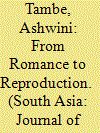

|
|
|
|
|
| Summary/Abstract |
This essay takes up for analysis how couples were represented in the cover art of the Marathi women’s magazine, Stree, from 1935 to 1965. Stree was the longest continuously running women’s magazine in Marathi (published from 1930 to 1986) and had a strong visual identity that benefited from cover images painted by noted artists. I focus here on a contrast that is evident between how couples were represented before and after Independence. Between 1935 and 1947, the hallmark image on the covers was the romantic couple, with alluring women as central figures. After Independence, between 1947 and 1965, the romantic couple receded from view and was replaced by scenes of comfortable and responsible mothering and domesticity. Depictions of premarital romance dropped, and women became components in a household tableau rather than the focus of romantic pursuit. In contrast with the Anglicised notions of glamour used in the 1930s, we also find a more explicitly Hindu aesthetic in the frequent representations of religious rituals and weddings. I treat these changing themes as an expression of the visual idiom of nation-building in mid twentieth century India. The increasing Hinduisation of couples in Stree covers reflects a post-Partition ethos of channelling conjugality along specifically majoritarian religious lines. The shunning of frivolity and the turn towards family and nation-building in this cultural text illustrates, in effect, how nationalism can shore up and promote very segregated gender relations.
|
|
|
|
|
|
|
|
|
|
|
|
|
|
|
|
| 5 |
ID:
158264
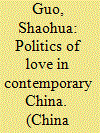

|
|
|
|
|
| Summary/Abstract |
Since the new millennium, the television industry in China has witnessed a flourishing of television series addressing the aspirations, struggles and gender expectations of the urban middle class. Nevertheless, with few exceptions, little scholarly attention has been devoted to the televisual construction of masculine ideals in the contemporary era. Taking as a case study Best Time (最美的时光), one of the most popular idol dramas of 2013, this article fills a lacuna in current scholarship and addresses the televisual construction of cosmopolitan masculinities by focusing on the tension between two prominent social groups: overseas returnees and indigenous talents. Through analysis of the construction of competing masculinities in Best Time, this article argues that this drama is as much about an undertone of national rejuvenation, and the desire for China’s rise and global dominance, as it is about unrequited love. In pursuing this argument, a critical reading of a youth idol drama opens new avenues for understanding cosmopolitanism through the lenses of gender dynamics and nationalism.
|
|
|
|
|
|
|
|
|
|
|
|
|
|
|
|
| 6 |
ID:
158263
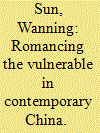

|
|
|
|
|
| Summary/Abstract |
Several decades of economic reform have transformed China into one of the world’s most unequal countries. However, because this inequality has been studied primarily at the structural level, we know little about how it impacts on intimate relationships and affects individuals’ experiences of love and romance. This article engages with this question through a case study of ‘Love on the Assembly Line’, a series of ‘wedding photos’ featuring Chinese rural migrant workers, and the subsequent series of television reports of the same name, dating from 2012–13. It first examines the political-economic context of this minor cultural phenomenon, then examines current contestations over the meaning of love and romance, and finally documents the responses of rural migrant individuals themselves to the project. Combining ethnographic observation, in-depth interviews, and critical discourse analysis, this discussion goes some way towards demonstrating how inequality of emotion can be fruitfully studied, thereby advancing a new and alternative approach to researching inequality in China – one that views love/romance as a cluster of contested cultural narratives and discourses; as a social practice that involves a particular form of distributive injustice; as an integral part of class politics; and as the product of the interaction of these three realms.
|
|
|
|
|
|
|
|
|
|
|
|
|
|
|
|
|
|
|
|
|